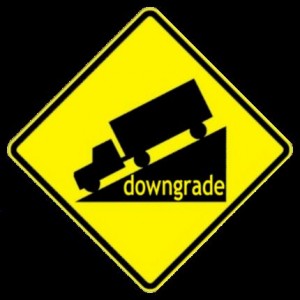
From Moody’s late yesterday:
New York, November 14, 2012 — Moody’s Investors Service has placed the A3 senior debt rating of QBE Insurance Group Limited (QBE; QBE.AX) on review for possible downgrade. The action follows the company’s 12 November announcement of estimated losses arising from Hurricane Sandy in the northeast US, drought-related losses for its US crop insurance segment, as well as reserve additions to its US commercial insurance segment, all of which will pressure 2012 profitability, constrain internal capital generation and weaken fixed charge coverage. QBE also stated that it intends to raise capital near-term through the issuance of $500 million in convertible subordinated notes, primarily to strengthen the capital of certain of its North American subsidiaries, as well as to pay down maturing short-term debt.
The review follows Moody’s decision earlier this year to revise its outlook on QBE’s debt ratings to negative from stable. The present rating review applies to the holding company and its debt-issuing subsidiaries only, and does not address QBE Lenders’ Mortgage Insurance Limited (QBE LMI), the group’s Australian mortgage insurer, whose Aa3 insurance financial strength rating was placed under review for possible downgrade by Moody’s on May 31, 2012.
RATINGS RATIONALE
“The review for possible downgrade primarily reflects Moody’s concerns regarding the group’s sustained elevated financial and operational leverage profile, as well as its weakened earnings, internal capital generation and debt service coverage measures in light of the company’s recent announcement”, according to Alan Murray, lead analyst for QBE. Although QBE’s management expects operating income for 2012 (before amortization of intangibles) to exceed $1 billion, estimated total 2012 catastrophes (including Hurricane Sandy), large individual risk losses and associated reserves for the full year 2012 are now expected to exceed $1.8 billion, or approximately 12% of consolidated group full-year net earned premiums.
Moody’s rating review will focus on the following: 1) an assessment of group-wide risk-adjusted capital adequacy and operational leverage, as well as evolving regulatory measures for assessing capital adequacy and solvency margins; and 2) the group’s prospective capital structure, financial leverage profile and fixed charge coverage, taking into consideration acquisition-related goodwill and group-wide capital management plans. Additionally, Moody’s said that the review will consider an assessment of QBE’s aggregate worldwide exposures to catastrophe losses; the impact on prospective operating margins of increased regulatory scrutiny on the US lender-placed homeowner insurance sector, in which QBE is a market leader; the extent of parent company’s access to internal liquidity both from regulated (i.e. insurance subsidiary) and non-regulated subsidiaries (e.g. Agency operations); and the resolution of the ongoing rating review of QBE LMI.
Factors that could lead to a confirmation of the ratings with a stable outlook include the following: 1) trending toward and maintaining capital at or above 1.7x required regulatory solvency margin (under current APRA framework) and a reduction in gross underwriting leverage to below 3.5x on a nominal basis, or below 4.5x on a tangible basis (excl. goodwill); 2) sustained reduction in financial leverage ratio to approximately 30% or less on a nominal basis, and to 35% or lower on a tangible basis (excl. goodwill); 3) sustained earnings strength and underwriting performance, resulting in consistent returns on capital in excess of 10% and combined ratios in low-90% range or lower.
Factors that could lead to a downgrade include the following: 1) deterioration in credit risk profile of one or more significant subsidiaries; 2) a material reduction in QBE’s earnings strength and/or underwriting profitability, leading to returns on average capital consistently falling below 8%; 3) sustained financial leverage above 30% on a nominal basis (or above 40% on a tangible basis), and/or a drop in earnings coverage to below 8x; 4) a sustained weakening in local solvency margin (e.g. continuing at or below 1.5x current minimum Australian regulatory (APRA) regulatory capital levels), or a persistent gross underwriting leverage ratio above 4x, or above 5x on a tangible basis (excluding goodwill); 4) significant losses due to catastrophes or other operating losses, resulting in a more-than-10% decline in shareholders’ equity over a 12-month period; 5) further material acquisitions that would significantly increase goodwill intangibles, e.g. by 10% or more.

